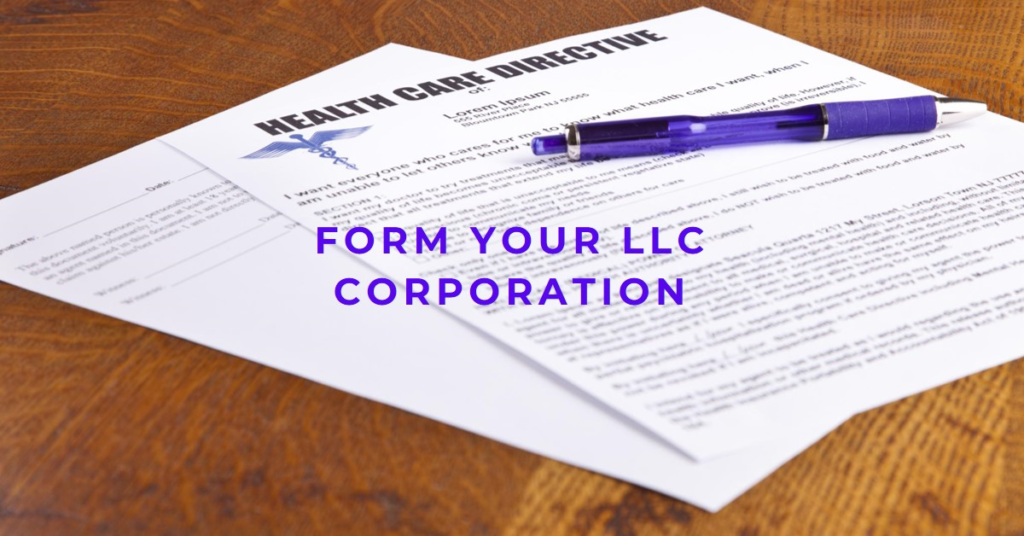When you’re ready to start your business, one of the most important decisions is choosing the right legal structure. Many business owners decide to form an LLC corporation because it offers flexibility, liability protection, and tax advantages. In this comprehensive step-by-step guide, we’ll walk you through how to form an LLC corporation with ease. What […]

How to Form an LLC Corporation: Step-by-Step Guide
Blueprint
- Michael Wesonga
- 4 October, 2024
SAVE TIME & MONEY SETTING UP YOUR LLC
- Setup Your LLC: Make the right decision based on your situation
- Save Money: Compare your costs on our continually updated LLC Calculator
- Bonuses: Visit the bonus section for a 2024 accounting calendar and more!

Thank you!
You have successfully joined our subscriber list.
When you’re ready to start your business, one of the most important decisions is choosing the right legal structure. Many business owners decide to form an LLC corporation because it offers flexibility, liability protection, and tax advantages. In this comprehensive step-by-step guide, we’ll walk you through how to form an LLC corporation with ease.
What is an LLC Corporation?
Before we dive into the process of how to form an LLC corporation, it’s essential to understand what an LLC corporation actually is. A Limited Liability Company (LLC) combines the benefits of a corporation’s liability protection with the flexibility of a partnership or sole proprietorship. When you form an LLC corporation, you shield your personal assets from business liabilities, while also having more control over the management and taxation of your business.
Step 1: Choose a Unique Business Name
The first step to form an LLC corporation is selecting a unique business name. The name must comply with the state’s LLC naming rules and should be easily distinguishable from other registered entities. Most states require the business name to include “Limited Liability Company” or an abbreviation like “LLC” or “L.L.C.” This helps indicate that your company is an LLC, providing clarity and professionalism.
When choosing a name, keep these points in mind:
- Uniqueness: The name must not be already in use by another LLC in your state.
- Availability: Check the availability of your desired name through your state’s business database.
- Domain name: Ensure that the business name is also available as a domain for your website.
Selecting the right name is crucial when you want to form an LLC corporation, as it will represent your brand and give you a professional identity.
Step 2: Appoint a Registered Agent
The next step in how to form an LLC corporation involves appointing a registered agent. A registered agent is a person or company authorized to receive legal documents on behalf of the LLC. This role is critical because it ensures that your LLC receives important legal notifications, such as lawsuits or government correspondence.
Here’s what to consider when choosing a registered agent:
- State Requirements: Most states require an LLC to have a registered agent located in the same state.
- Availability: The registered agent must be available during regular business hours.
- Professional Service: You can either serve as the registered agent yourself or hire a professional registered agent service to handle this role for you, such as Northwest Registered Agent or Registered Agents Inc.
Having a registered agent in place is essential when you decide to form an LLC corporation, as it maintains the flow of legal communications.
Step 3: File the Articles of Organization
One of the most important steps in the process to form an LLC corporation is filing the Articles of Organization. This document is also known as a Certificate of Formation or Certificate of Organization in some states. It officially registers your LLC with the state, making it a recognized legal entity.
When filing your Articles of Organization, you’ll need to provide key details, including:
- Business Name: The LLC’s official name.
- Registered Agent: The name and address of your registered agent.
- LLC Members: The names of the LLC members (owners).
- Management Structure: Whether the LLC is member-managed or manager-managed.
Most states allow you to file this document online, which can significantly speed up the process. Once the state processes your filing, your LLC will officially be recognized.
To simplify the process, consider using online filing services like ZenBusiness or Swyft Fillings.
Step 4: Create an LLC Operating Agreement
Although not required in every state, drafting an LLC Operating Agreement is a vital step when you form an LLC corporation. This internal document outlines the rules and regulations for how your LLC will operate. It helps prevent future disputes and provides a clear structure for managing the company.
Here’s what an LLC Operating Agreement typically covers:
- Ownership Structure: The percentage of ownership among LLC members.
- Profit Distribution: How profits and losses will be allocated to members.
- Decision-Making: How business decisions will be made and who has authority.
- Management Structure: If your LLC will be member-managed or managed by appointed managers.
By having a well-drafted Operating Agreement, you ensure smooth operations as you form an LLC corporation and navigate your business’s growth.
Step 5: Apply for an EIN (Employer Identification Number)
An EIN, or Employer Identification Number, is a federal tax ID number issued by the IRS. You’ll need this number for tax purposes, to open a business bank account, and to hire employees. Applying for an EIN is a critical step when you form an LLC corporation, and it’s a relatively simple process.
Here’s how to obtain an EIN:
- Online Application: Visit the IRS website and apply online.
- Mail or Fax: You can also apply by mailing or faxing Form SS-4 to the IRS.
Once you have your EIN, you can start conducting business legally and set up your financial structure.
Step 6: Open a Business Bank Account
After obtaining your EIN, the next step in how to form an LLC corporation is opening a business bank account. This separates your personal and business finances, which is crucial for liability protection and tax purposes. Having a dedicated business bank account simplifies bookkeeping and ensures that your LLC remains compliant with state regulations.
When opening a business bank account, consider the following:
- LLC Documents: Bring your Articles of Organization, EIN, and Operating Agreement.
- Personal ID: Provide identification documents for the LLC members.
- Business Name: Ensure the account is opened under the LLC’s official name.
Opening a business bank account is an important financial step when you decide to form an LLC corporation.
Step 7: File for Necessary Business Licenses and Permits
To legally operate your LLC, you may need specific business licenses and permits based on your location and industry. These requirements vary by state, city, and type of business, so it’s essential to research what’s necessary to remain compliant.
Here are a few common types of licenses and permits:
- General Business License: Required by most cities or counties to operate.
- Zoning Permits: Ensure your business operates in the correct zone.
- Health and Safety Permits: Necessary for businesses in certain industries, such as food services.
For help with ensuring compliance, consider services like Tailor Brands or Bizee to streamline your operations.
Step 8: Stay Compliant with State Requirements
After you’ve completed the initial steps to form an LLC corporation, it’s important to maintain compliance with ongoing state requirements. Most states require LLCs to file annual or biennial reports and pay associated fees. Additionally, if you change the registered agent, business address, or LLC members, you’ll need to update your Articles of Organization with the state.
Keeping up with these requirements ensures that your LLC remains in good standing and avoids penalties.
Here is an insightful video on how to maintain our LLC once you have observed the above:
LLC vs. Corporation: Key Differences to Consider
While you’ve decided to form an LLC corporation, it’s important to understand how an LLC compares to a corporation. The key differences include:
- Taxation: LLCs offer pass-through taxation, meaning profits and losses pass through to the owners’ personal tax returns. Corporations are subject to double taxation, where profits are taxed at the corporate level and again when distributed to shareholders.
- Management Structure: LLCs offer flexibility in management, allowing owners to choose between member-managed and manager-managed structures. Corporations have a more rigid structure with a board of directors.
- Formalities: LLCs have fewer formal requirements, such as no mandatory annual meetings or detailed corporate records. Corporations are required to hold formal meetings and keep detailed records.
- Flexibility: LLCs offer more flexibility in terms of ownership and profit distribution. Corporations must distribute profits based on stock ownership.
Understanding these differences helps you determine why forming an LLC corporation may be the best choice for your business.
Final Thoughts
By following these steps, you can form an LLC corporation and establish a strong foundation for your business. The process includes choosing a name, appointing a registered agent, filing the Articles of Organization, creating an Operating Agreement, and staying compliant with state requirements. As your LLC grows, these steps will ensure that you have the legal protections and operational flexibility you need to succeed.
Make sure to carefully follow each step and consult with professionals if needed to streamline the process and avoid costly mistakes
Empowering individuals by providing accessible, actionable information is key to helping them achieve success. By equipping people with the knowledge and tools they need, we enable informed decision-making and foster personal and professional growth.
This website uses cookies so that we can provide you with the best user experience possible. Cookie information is stored in your browser and performs functions such as recognising you when you return to our website and helping our team to understand which sections of the website you find most interesting and useful.
Strictly Necessary Cookie should be enabled at all times so that we can save your preferences for cookie settings.
If you disable this cookie, we will not be able to save your preferences. This means that every time you visit this website you will need to enable or disable cookies again.



